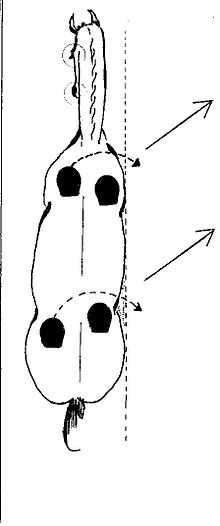Leg-yield

The leg-yield is a lateral movement performed on a horse, in which the horse travels both sideways and forward at the same time. The horse is fairly straight through his body in the leg-yield, although he may have a slight bend to the outside (away from the direction of travel). It is one of the "three initial movements leading up to true lateral work", the others being the turn on the forehand and the shoulder-fore.[1]
Difference between the leg-yield and half-pass
The leg-yield and half-pass are sometimes confused because they are both movements in which the horse goes forward and sideways. However, the half-pass is quite a bit more advanced, requiring greater balance, engagement, and collection from the horse. In the leg-yield, the horse is fairly straight or looking slightly away from the direction of travel. In the half-pass, the horse is bent towards the direction of travel, which is physically much more difficult for the horse.
Uses and disadvantages of the leg-yield
The leg-yield is one of the first lateral exercises to be introduced to a horse, teaching him a simple yet valuable lesson: to move sideways away from leg pressure. This basic is later built upon in the shoulder-in and haunches-in.
Many top trainers do not believe that the leg-yield is a particularly useful exercise after this concept has been taught, falling short when compared to such exercises as the shoulder-in. However, the leg-yield is asked for in early dressage tests.
The second great use of the leg-yield is in the rider's training, as it is a fairly basic move yet it can begin to teach the rider how to use the riding aids independently and bring the horse properly into the outside rein and leg.
Over-use of the leg-yield can have a negative effect on a horse's training, causing them to lose the all-important forwardness, and may cause short, broken gaits. The Spanish Riding School uses this exercise sparingly, only at the walk when first teaching the horse to move away from the leg, because the horse will be bent in the opposite direction when he learns the more difficult half-pass and so it is believed to be counter-productive to spend much time on the leg-yield.
Different ways to leg-yield
The most common place the leg-yield is performed is from quarterline to rail, keeping the horse's body parallel to the wall. With more advanced horses, leg-yielding can be performed back to the quarterline.
The second way the leg-yield is commonly performed is with the horse's nose facing the rail, with his body at no more than a 30-degree angle to the wall. The horse may also be leg-yielded with his haunches to the wall. Unlike shoulder- or haunches-in, the horse does not have the same degree of bend. These are not' the same movements. The horse may also be leg-yielded on a diagonal, keeping his body straight.
The last form of leg-yielding is much more advanced, and is not commonly practised. In this movement, the horse is leg-yielded on a volte, with his nose facing the center of the circle.
References
- ↑ Cf. Loriston-Clarke, p. 77. - Davison, p. 53, calls it "the first preliminary lateral exercise".
Sources
- Richard Davison, Dressage Priority Points, Howell Book House, New York 1995
- Jennie Loriston-Clarke, The Complete Guide to Dressage. How to Achieve Perfect Harmony between You and Your Horse. Principal Movements in Step-by-step Sequences Demonstrated by a World Medallist, Quarto Publishing plc, London 1987, reprinted 1993